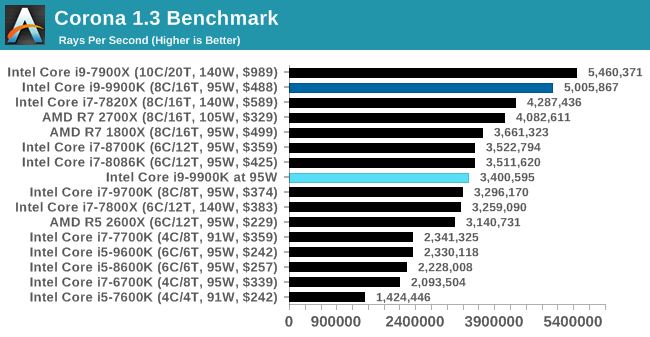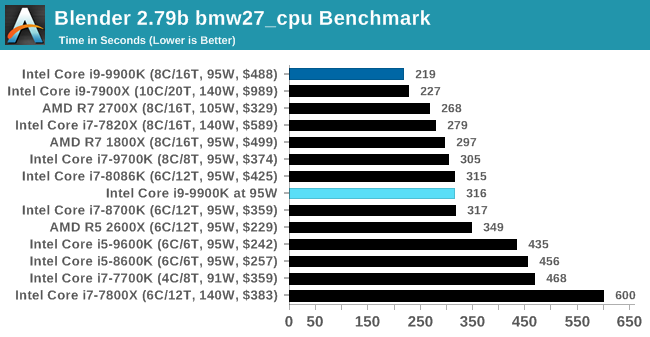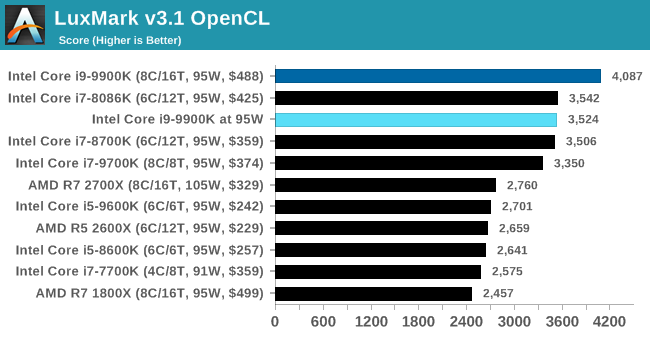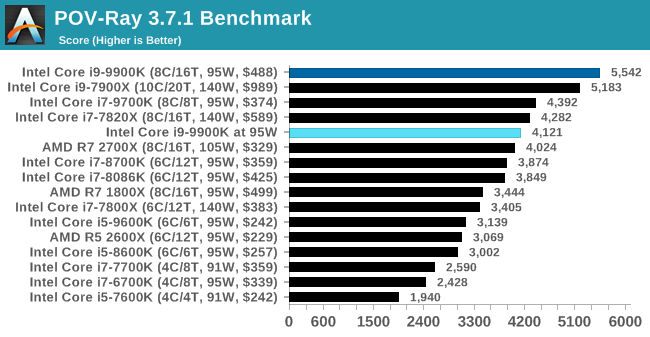The Intel Core i9-9900K at 95W: Fixing The Power for SFF
by Ian Cutress on November 29, 2018 8:00 AM ESTCPU Performance: Rendering Tests
Rendering is often a key target for processor workloads, lending itself to a professional environment. It comes in different formats as well, from 3D rendering through rasterization, such as games, or by ray tracing, and invokes the ability of the software to manage meshes, textures, collisions, aliasing, physics (in animations), and discarding unnecessary work. Most renderers offer CPU code paths, while a few use GPUs and select environments use FPGAs or dedicated ASICs. For big studios however, CPUs are still the hardware of choice.
All of our benchmark results can also be found in our benchmark engine, Bench.
Corona 1.3: Performance Render
An advanced performance based renderer for software such as 3ds Max and Cinema 4D, the Corona benchmark renders a generated scene as a standard under its 1.3 software version. Normally the GUI implementation of the benchmark shows the scene being built, and allows the user to upload the result as a ‘time to complete’.
We got in contact with the developer who gave us a command line version of the benchmark that does a direct output of results. Rather than reporting time, we report the average number of rays per second across six runs, as the performance scaling of a result per unit time is typically visually easier to understand.
The Corona benchmark website can be found at https://corona-renderer.com/benchmark

When we apply a full-fat rendering test, the 9900K at 95W scores around the i7-9700K which is a similar CPU with no hyperthreading.
Blender 2.79b: 3D Creation Suite
A high profile rendering tool, Blender is open-source allowing for massive amounts of configurability, and is used by a number of high-profile animation studios worldwide. The organization recently released a Blender benchmark package, a couple of weeks after we had narrowed our Blender test for our new suite, however their test can take over an hour. For our results, we run one of the sub-tests in that suite through the command line - a standard ‘bmw27’ scene in CPU only mode, and measure the time to complete the render.
Blender can be downloaded at https://www.blender.org/download/

Similar scenes with Blender, where the 9900K at 95W is actually 50% slower, and performs around the mark of the 9700K.
LuxMark v3.1: LuxRender via Different Code Paths
As stated at the top, there are many different ways to process rendering data: CPU, GPU, Accelerator, and others. On top of that, there are many frameworks and APIs in which to program, depending on how the software will be used. LuxMark, a benchmark developed using the LuxRender engine, offers several different scenes and APIs.
In our test, we run the simple ‘Ball’ scene on both the C++ and OpenCL code paths, but in CPU mode. This scene starts with a rough render and slowly improves the quality over two minutes, giving a final result in what is essentially an average ‘kilorays per second’.


The drop in our Luxmark test isn't as severe as what we see in blender, but the 95W mode causes the 9900K to be again around the level of a 9700K.
POV-Ray 3.7.1: Ray Tracing
The Persistence of Vision ray tracing engine is another well-known benchmarking tool, which was in a state of relative hibernation until AMD released its Zen processors, to which suddenly both Intel and AMD were submitting code to the main branch of the open source project. For our test, we use the built-in benchmark for all-cores, called from the command line.
POV-Ray can be downloaded from http://www.povray.org/













101 Comments
View All Comments
GreenReaper - Saturday, December 1, 2018 - link
I'm not so sure it's as big a win in most cases as it's cracked up to be, especially now that new security measures are required to prevent threads on the same core from being able to use Spectre-class attacks to divulge secrets from timing based on data accessed by other thread.stux - Thursday, November 29, 2018 - link
Apparently a post with an ‘at mark’ in it is spam...Harry_Wild - Thursday, November 29, 2018 - link
I thinking about replacing my proprietary Lenovo Thinkstation P300 motherboard. It is so limited and Lenovo does not update their PC BIOS like other manufacturers to keep the PC up to date with new hardware. Lenovo answer is to buy a new Lenovo PC! Just have to find a new one about the same size and I will jerry rig it in.bairlangga - Thursday, November 29, 2018 - link
So, basically with the power limit in place an 8C-16T i9-9900k is an 8C-16T i7-7820x in a different tshirt riding a different cars, being uncapped is like giving it the pass to run on the autobahn.While we've know that Ryzen 1800x had blown the 7820x out of the water. No more IPC increment for Intel, it seems.
SanX - Thursday, November 29, 2018 - link
IanThe most amazing thing you have revealed in your benchmarks over few last months was the crazy speedup of avx512 on 3D Particle movement which put all recent HEDT incarnations both from Intel and AMD deep into the mud. And in this paper you removed this test. Where is 7900x in the second plot? Or your test was buggy showing these crazy 5x improvements even 7th gen over 9th gen when avx512 was on?
HollyDOL - Friday, November 30, 2018 - link
That would be interesting to see. While AVX can do wonders if the workload is suitable, it IS power hungry. I guess you would still end up with better performance ("tasks per kWh") even with the power limit, but hard to say by how much.I can see on my 8700 how much power at wall and core temp rises when it gets loaded with something AVX heavy.
xTRICKYxx - Friday, November 30, 2018 - link
Once the 9900k is at 95w, the 2700X is looking far more competitive.sharath.naik - Friday, November 30, 2018 - link
You missed come nebench scoresDeath666Angel - Friday, November 30, 2018 - link
Wouldn't mind some tuned undervolted tests for the top consumer processors out right now. :)Consumer1 - Friday, November 30, 2018 - link
Would you be so kind as to change the price of the 9900K in your graphs to the list prices for which it can actually be bought at Amazon and Newegg? Those prices are $579 and $569 respectively when not on sale. It is deceptive to keep listing it at $488.